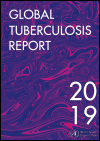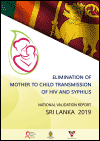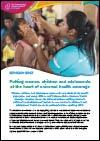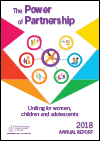What's New
Displaying results 1011 - 1020 of 4911

Resource | Publications,
Viet Nam is facing a rapidly growing HIV epidemic that is beginning to extend beyond initial concentrations in networks of injecting drug users and sex workers. The number of people living with HIV doubled between 2000 and 2005, from approximately 122,000 to 263,000. The adult HIV prevalence is estimated to be 0.5% at the national level in 2005 but exceeded 1% in several provinces. There were an estimated 37,000 new infections in 2005. Due to increased heterosexual transmission, the number of infected females compared with males is increasing each year. In 2005, the ratio was estimated to be 2 to 1, males to females. The number of AIDS-related deaths is growing and is estimated to have increased from 9000 in 2003 to 14,000 in 2005.

Resource | Publications,
TB remains one of the top 10 causes of death worldwide. Millions of people continue to fall sick from TB each year. The Global TB Report 2019 provides a comprehensive and up-to-date assessment of the TB epidemic, and progress in the response, at global, regional and country levels. It features data on disease trends and the response to the epidemic in 202 countries and territories.
The Global Report includes trends in TB incidence and mortality, data on case detection and treatment results for TB, multidrug-resistant TB (MDR-TB), TB/HIV, TB prevention, universal health coverage as well as financing. It presents progress towards targets set at the first-ever United Nations General Assembly high-level meeting on TB in 2018, that brought together heads of state, as well as the targets of the WHO End TB Strategy and the Sustainable Development Goals.
The report also includes an overview of pipelines for new TB diagnostics, drugs and vaccines. Additionally, it outlines a monitoring framework that features data on SDG indicators that can be used to identify key influences on the TB epidemic at national level and inform the multi-sectoral actions required to end the TB epidemic.

Resource | Publications,
The first case of HIV infection in Papua New Guinea was detected in 1987. By June 2005, 12,341 people had been reported to be living with HIV/AIDS. The country is facing a generalized epidemic with rapidly increasing prevalence in a difficult socioeconomic context. A national epidemiological consensus meeting in November 2004 estimated an average prevalence rate of 1.7%, and between 25,000 and 69,000 people with 15-49 years were living with HIV/AIDS. Prevalence rates among women attending antenatal care services are estimated to vary between 1% and 4%. Available data suggests that the epidemic is predominantly transmitted through heterosexual contact (84%), fuelled by high-risk behaviour including widespread commercial and casual sex. Approximately 93.1% of current reported cases are adults.

Resource | Publications,
Under Universal Health Coverage, all people should have access to quality health services that meet their needs without incurring financial hardship. Rapid economic development in the Western Pacific Region has been accompanied by a decrease in external funding for prevention and control programmes for HIV, viral hepatitis and sexually transmitted infections (STIs), requiring transition to domestic funding for health. This document introduces approaches to health financing, summarises key user fee and service coverage indicators.

Resource | Publications,
Sixteen women living with HIV and 36 women with syphilis delivered during 2018. All pregnant women with HIV received treatment following national protocols, and the new-borns remain free of infection. Among pregnant women with syphilis, 97% received treatment and annual rate of congenital syphilis was 1.5 per 100 000 live births. Process indicators have improved with 97.5% in 2017 and 96.4% in 2018 for coverage of ANC attendance. These figures have been achieved through the government services. The screening coverage of pregnant women for HIV was 95.2% in 2017 and 95.9% in 2018 and for syphilis was 96.9% in 2017 and 99.3% in 2018.

Resource | Publications,
The Sustainable Development Goals and global political momentum behind Universal Health Coverage (UHC) offer significant opportunities to build collective global and national action towards achieving universal health coverage for adolescents. This paper sets out the evidence base on adolescent health and makes the case that to achieve Universal Health Coverage, policy makers need to take urgent action in the areas of service delivery, financing and governance.

Resource | Publications,
This Advocacy Brief from PMNCH on women, children and adolescents in universal health coverage (UHC) summarizes the key global evidence and arguments why the health needs of women, children and adolescents is central to the achievement of universal health coverage and the SDGs. It also demonstrates the return on investment for proven and cost-effective women, children and adolescent health interventions in terms of equity, human rights and economic productivity. This brief is intended for use as an advocacy resource, to encourage partners to unite around priority messages on UHC.

Resource | Publications,
2018 was an extraordinary year for PMNCH, with the diversity of our work showcased at the 2018 Partners’ Forum. Other achievements included our work in a number of EWEC focus areas, country engagement, accountability, political engagement and resource mobilization. The Board and Executive Committee also adopted the PMNCH 2018-2020 Business Plan.

Resource | Publications,
The Implementing Rules and Regulations (IRR) shall prescribe guidelines, procedures and standards for the implementation of the mandates and objectives of R.A. No. 11166, and to ensure and facilitate compliance to its provisions.

Resource | Publications,
S&D are globally recognized as key barriers to an effective HIV response. S&D by health care providers towards PLHIV, as well as populations at higher risk of HIV exposure, such as people who inject drugs (PWID), men who have sex with men (MSM), female sex workers (FSW) and Transgender persons (TG), can impact whether people feel comfortable accessing services for HIV related testing care and treatment.





